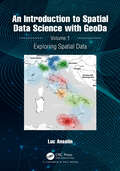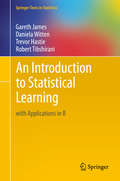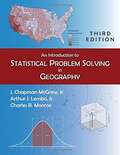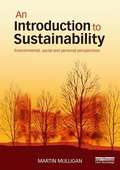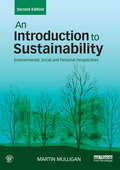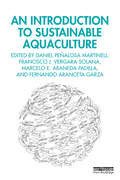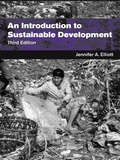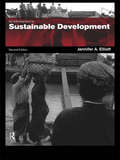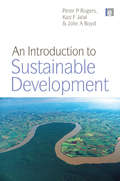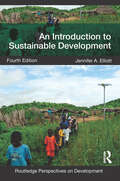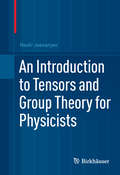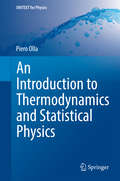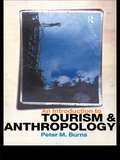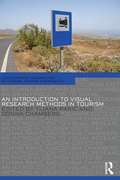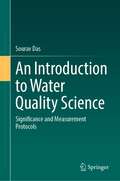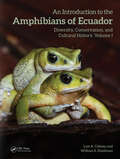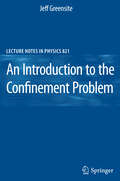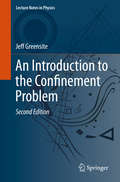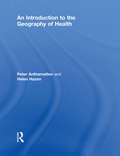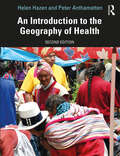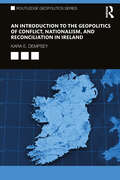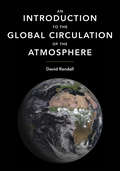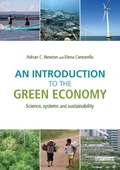- Table View
- List View
An Introduction to Spatial Data Science with GeoDa: Volume 1: Exploring Spatial Data
by Luc AnselinThis book is the first in a two-volume series that introduces the field of spatial data science. It offers an accessible overview of the methodology of exploratory spatial data analysis. It also constitutes the definitive user’s guide for the widely adopted GeoDa open-source software for spatial analysis. Leveraging a large number of real-world empirical illustrations, readers will gain an understanding of the main concepts and techniques, using dynamic graphics for thematic mapping, statistical graphing, and, most centrally, the analysis of spatial autocorrelation. Key to this analysis is the concept of local indicators of spatial association, pioneered by the author and recently extended to the analysis of multivariate data.The focus of the book is on intuitive methods to discover interesting patterns in spatial data. It offers a progression from basic data manipulation through description and exploration to the identification of clusters and outliers by means of local spatial autocorrelation analysis. A distinctive approach is to spatialize intrinsically non-spatial methods by means of linking and brushing with a range of map representations, including several that are unique to the GeoDa software. The book also represents the most in-depth treatment of local spatial autocorrelation and its visualization and interpretation by means of GeoDa.The book is intended for readers interested in going beyond simple mapping of geographical data to gain insight into interesting patterns. Some basic familiarity with statistical concepts is assumed, but no previous knowledge of GIS or mapping is required.Key Features:• Includes spatial perspectives on cluster analysis• Focuses on exploring spatial data• Supplemented by extensive support with sample data sets and examples on the GeoDaCenter websiteThis book is both useful as a reference for the software and as a text for students and researchers of spatial data science.Luc Anselin is the Founding Director of the Center for Spatial Data Science at the University of Chicago, where he is also the Stein-Freiler Distinguished Service Professor of Sociology and the College, as well as a member of the Committee on Data Science. He is the creator of the GeoDa software and an active contributor to the PySAL Python open-source software library for spatial analysis. He has written widely on topics dealing with the methodology of spatial data analysis, including his classic 1988 text on Spatial Econometrics. His work has been recognized by many awards, such as his election to the U.S. National Academy of Science and the American Academy of Arts and Science.
An Introduction to Statistical Learning: with Applications in R (Springer Texts in Statistics #103)
by Trevor Hastie Gareth James Robert Tibshirani Daniela WittenAn Introduction to Statistical Learning provides an accessible overview of the field of statistical learning, an essential toolset for making sense of the vast and complex data sets that have emerged in fields ranging from biology to finance to marketing to astrophysics in the past twenty years. This book presents some of the most important modeling and prediction techniques, along with relevant applications. Topics include linear regression, classification, resampling methods, shrinkage approaches, tree-based methods, support vector machines, clustering, and more. Color graphics and real-world examples are used to illustrate the methods presented. Since the goal of this textbook is to facilitate the use of these statistical learning techniques by practitioners in science, industry, and other fields, each chapter contains a tutorial on implementing the analyses and methods presented in R, an extremely popular open source statistical software platform. Two of the authors co-wrote The Elements of Statistical Learning (Hastie, Tibshirani and Friedman, 2nd edition 2009), a popular reference book for statistics and machine learning researchers. An Introduction to Statistical Learning covers many of the same topics, but at a level accessible to a much broader audience. This book is targeted at statisticians and non-statisticians alike who wish to use cutting-edge statistical learning techniques to analyze their data. The text assumes only a previous course in linear regression and no knowledge of matrix algebra.
An Introduction to Statistical Problem Solving in Geography
by J. Chapman McGrew Arthur J. Lembo Charles B. MonroeGeography students need a solid introduction to the variety of ways in which statistical procedures are used to explore and solve realistic geographic problems. This book is designed to provide a comprehensive and understandable introduction to statistical methods in a practical, problem solving framework. Students who use this text in a spatial analysis or statistical methods course should acquire a well-grounded foundation and feel comfortable in applying statistical techniques in research problems or situations that they might encounter in their subsequent geographic education and careers. This book is targeted for undergraduate geography majors and beginning graduate students who do not have a strong background in statistical approaches to geographic problem solving.
An Introduction to Sustainability: Environmental, Social and Personal Perspectives
by Martin MulliganAn Introduction to Sustainability provides students with a comprehensive overview of the key concepts and ideas which are encompassed within the growing field of sustainability. The book teases out the diverse but intersecting domains of sustainability and emphasises strategies for action. Aimed at those studying the subject for the first time, it is unique in giving students from different disciplinary backgrounds a coherent framework and set of core principles for applying broad sustainability principles within their personal and professional lives. These include: working to improve equality within and across generations, moving from consumerism to quality of life goals and respecting diversity in both nature and culture. Areas of emerging importance such as the economics of happiness and wellbeing stand alongside core topics including: Energy and society Consumption and consumerism Risk and resilience Waste, water and land. Key challenges and applications are explored through international case studies and each chapter includes a thematic essay drawing on diverse literature to provide an integrated introduction to fundamental issues. Launched with the brand-new Routledge Sustainability Hub, the book's companion website contains a range of features to engage students with the interdisciplinary nature of Sustainability. Together these resources provide a wealth of material for learning, teaching and researching the topic of sustainability. This textbook is an essential companion to any sustainability course.
An Introduction to Sustainability: Environmental, Social and Personal Perspectives
by Martin MulliganAn Introduction to Sustainability provides students with a comprehensive overview of the key concepts and ideas which are encompassed within the growing field of sustainability. The fully updated second edition, including new figures and images, teases out the diverse but intersecting domains of sustainability and emphasises strategies for action. Aimed at those studying the subject for the first time, it is unique in giving students from different disciplinary backgrounds a coherent framework and set of core principles for applying broad sustainability principles within their own personal and professional lives. These include: working to improve equality within and across generations; moving from consumerism to quality of life goals; and respecting diversity in both nature and culture. Areas of emerging importance such as the economics of prosperity and wellbeing stand alongside core topics including: · Energy and society · Consumption and consumerism · Risk and resilience · Waste, water and land. Key challenges and applications are explored through international case studies, and each chapter includes a thematic essay drawing on diverse literature to provide an integrated introduction to fundamental issues. Housed on the Routledge Sustainability Hub, the book’s companion website contains a range of features to engage students with the interdisciplinary nature of sustainability. Together these resources provide a wealth of material for learning, teaching and researching the topic of sustainability. This textbook is an essential companion to any sustainability course.
An Introduction to Sustainable Aquaculture
by Daniel Peñalosa Martinell Vergara-Solana, Francisco J Araneda Padilla, Marcelo E Fernando Aranceta GarzaThis new textbook provides an accessible introduction to sustainable aquaculture through its relationship with three key pillars: the environment, the economy, and society.As the demand for seafood keeps increasing, aquaculture is considered one of the most promising and sustainable ways to satisfy this demand with nutritious and high-quality food. It is important to understand, therefore, the wider role and impact aquaculture has on the environment, the economy, and society. The book begins by providing a foundational introduction to aquaculture and sustainability, discussing the complex and interdependent relationship that exists between the two. The core text of the book is divided into four parts which focus on the environment, economics, social impacts, and governance and technologies. Chapters examine key issues surrounding climate change, food security, new technologies, bioeconomics and risk analysis, international cooperation, employment, and animal welfare, with the book concluding with a chapter examining the future directions and challenges for the aquaculture industry. The book draws on global case studies and each chapter is accompanied by recommended reading and chapter review questions to support student learning.This book will serve as an essential guide for students of aquaculture, fisheries management, and sustainable food, as well as practitioners and policymakers engaged in sustainable fishery development.
An Introduction to Sustainable Development
by Jennifer ElliottThis third edition of a successful, established text provides a concise and well-illustrated introduction to the ideas behind, and the practices flowing from the notion of sustainable development.
An Introduction to Sustainable Development
by Jennifer ElliottThis third edition of a successful, established text provides a concise and well-illustrated introduction to the ideas behind, and the practices flowing from the notion of sustainable development.
An Introduction to Sustainable Development
by Peter P. Rogers Kazi F. Jalal John A. BoydThis volume is the most comprehensive textbook on sustainable development. It has been developed with students and professionals from around the world specifically for those who need a thorough grounding in the subject. Coverage includes: background to sustainable development and global environmental issues; measurement and sustainability indicators; environmental assessment, management and policy; approaches and linkages to poverty reduction; impacts and infrastructure development; economics, consumption, production and market failures; governance; participation; disaster management; international financial institutions; international environmental agreements; and the role of civil society.
An Introduction to Sustainable Development (Routledge Perspectives on Development)
by Jennifer ElliottThis fourth edition has been comprehensively rewritten and updated to provide a concise, well illustrated and accessible introduction to the characteristics, challenges and opportunities of sustainable development with particular reference to developing countries. The contested nature of sustainable development is explored through a detailed consideration of changing ideas and practices within environmentalism and development thinking. The text identifies the different actors involved (from institutions of global governance through to community based organisations), the policies and mechanisms through which sustainable development is being sought and considers the outcomes for particular groups and environments in both rural and urban contexts. ?? This edition places stronger emphasis on the global challenges of sustainable development with an understanding of inter-linked crises in climate, energy, economy, poverty and social injustice. It explores how these issues are leading to deep questioning of what sustainable development is, what it should be, and how sustainable development policies and mechanisms are being reconsidered. The book gives new consideration to the challenge of achieving lower carbon growth, climate adaptation, and the implications on sustainable development of rapidly expanding economies, including China and India. It contains greater discussion of how civil society movements influence outcomes of international climate policy, as well as technological developments in energy and agriculture. The text also contains a substantially expanded discussion of how poverty remains central to sustainable development challenges, as revealed through the Millennium Ecosystem Assessment and Millennium Development Goals. This invaluable text retains the core message that sustainable development has become central to debates about environment and development. Containing a substantial number of new boxed case studies, learning outcomes, chapter summaries, discussion questions, further reading and websites, this text provides an essential introduction for students.
An Introduction to Tensors and Group Theory for Physicists
by Nadir JeevanjeeAn Introduction to Tensors and Group Theory for Physicists provides both an intuitive and rigorous approach to tensors and groups and their role in theoretical physics and applied mathematics. A particular aim is to demystify tensors and provide a unified framework for understanding them in the context of classical and quantum physics. Connecting the component formalism prevalent in physics calculations with the abstract but more conceptual formulation found in many mathematical texts, the work will be a welcome addition to the literature on tensors and group theory. Advanced undergraduate and graduate students in physics and applied mathematics will find clarity and insight into the subject in this textbook.
An Introduction to Thermodynamics and Statistical Physics (UNITEXT for Physics)
by Piero OllaThis textbook offers an advanced undergraduate or initial graduate level introduction to topics such as kinetic theory, equilibrium statistical mechanics and the theory of fluctuations from a modern perspective. The aim is to provide the reader with the necessary tools of probability theory and thermodynamics (especially the thermodynamic potentials) to enable subsequent study at advanced graduate level. At the same time, the book offers a bird's eye view on arguments that are often disregarded in the main curriculum courses. Further features include a focus on the interdisciplinary nature of the subject and in-depth discussion of alternative interpretations of the concept of entropy. While some familiarity with basic concepts of thermodynamics and probability theory is assumed, this does not extend beyond what is commonly obtained in basic undergraduate curriculum courses.
An Introduction to Tides
by Theo GerkemaThis textbook is a self-contained introduction to tides that will be useful for courses on tides in oceans and coastal seas at an advanced undergraduate and postgraduate level, and will also serve as the go-to book for researchers and coastal engineers needing information about tides. The material covered includes: a derivation of the tide-generating potential; a systematic overview of the main lunar periodicities; an intuitive explanation of the origin of the main tidal constituents; basic wave models for tidal propagation (e.g. Kelvin waves, the Taylor problem); shallow-water constituents; co-oscillation and resonance; frictional and radiation damping; the vertical structure of tidal currents; and a separate chapter on internal tides, which deals with ocean stratification, propagation of internal tides (vertical modes and characteristics) and their generation. Exercises are provided in each chapter.
An Introduction to Tourism and Anthropology
by Peter BurnsThis introductory text explains how anthropology is integral to the study of tourism dynamics. Starting with an overview of the development of anthropology as a social science, the author uses a wealth of international examples, including the UK, USA and Australia, to bring practical relevance to complex theories. With its lucid writing style, summaries, sample questions and suggestions for further reading, this book will be an invaluable teaching resource in this area.
An Introduction to Visual Research Methods in Tourism (Contemporary Geographies of Leisure, Tourism and Mobility)
by Donna Chambers Tijana RakićAn Introduction to Visual Research Methods in Tourism is the first book to present, discuss and promote the use of a range of visual methods in tourism studies. It introduces methods ranging from the collection of secondary visual materials for the purposes of analysis (such as postcards, tourism brochures, and websites) and the creation of visuals in the context of primary research (such as photography, video and drawings), to the production of data through photo-elicitation techniques. The book promotes thoroughly underpinned interdisciplinary visual tourism research and includes an exploration of many key philosophical, methodological and inter-disciplinary approaches. Comprised of five parts: introduction; paradigms, academic disciplines and theory; methods; analysis and representation; and conclusion. This volume informs and inspires its readers through a reliance on theory, examples from tourism studies conducted in various geographical locations and through key pedagogical features such as annotated further readings, practical tips boxes and concise chapter summaries. This book will be of interest to experienced visual tourism researchers, scholars wishing to incorporate visual methods in their studies of tourism for the very first time, as well as students on undergraduate, postgraduate or doctoral programmes who are contemplating the incorporation of visual methods in their studies of tourism.
An Introduction to Water Quality Science: Significance and Measurement Protocols
by Sourav DasThis book discusses the significance of water quality parameters in aquatic ecosystems, offering a concise and practical measurement methodology for early career researchers and post-graduate students in the fields of environmental science, oceanography, and aquatic science . The keys topics covered include aquatic sampling, basics of physicochemical properties and carbonate chemistry of aquatic science , the importance of nutrients in natural water bodies, biological productivity in aquatic ecosystems, aquatic pollution, and statistical analyses of different types of water science data. Several parameters such as microplastics, dimethylsulfoniopropionate and polychlorinated biphenyls have also been incorporated in the book for comprehensive coverage of the topic. The book is meant as a practical guide for beginners and young researchers using a clear writing style and practical examples, highlighting the significance of water science parameters and their measurement protocols in aquatic environments.
An Introduction to the Amphibians of Ecuador: Diversity, Conservation, and Cultural History
by William E. Duellman Luis A. ColomaAn Introduction to the Amphibians of Ecuador is the first of four volumes, which are comprehensive, well-illustrated, and authoritative works, making them invaluable to biologists, conservationists, and others. This initial volume delves into the cultural history of amphibians, encompassing ethnobatrachology and folklore, while summarizing the amphibian iconography found in Ecuadorian archaeology. Moreover, it covers topics such as bioprospecting, sustainable management, and biotrade activities. The history and present state of amphibian biology research are also addressed. Furthermore, it explores in comprehensive detail the rich amphibian diversity of Ecuador, providing a thorough review of biogeography, amphibian declines, and conservation.Subsequent volumes list the characteristics of each species, define each taxon, and compare them to similar other species. Natural history and reproductive behavior, where known, are described, as are data on vocalizations, larvae, and ontogenetic changes. Amphibian distributions are illustrated with physiographic maps with dots. Each volume addresses the declines, extinctions, and conservation status of each species and provides notations of their occurrence in reserves.KEY FEATURES Summarizes the ethnozoological aspects of amphibians Provides a thorough history of research Introduction to three volumes providing accounts for each of the 3 orders, 19 families, 78 genera, and over 650 species from Ecuador
An Introduction to the Chemistry of the Sea
by Michael E. Q. PilsonFully updated and expanded, this new edition provides students with an accessible introduction to marine chemistry. It highlights geochemical interactions between the ocean, solid earth, atmosphere and climate, enabling students to appreciate the interconnectedness of Earth's processes and systems and elucidates the huge variations in the oceans' chemical environment, from surface waters to deep water. Written in a clear, engaging way, the book provides students in oceanography, marine chemistry and biogeochemistry with the fundamental tools they need for a strong understanding of ocean chemistry. Appendices present information on seawater properties, key equations and constants for calculating oceanographic processes. New to this edition are end-of-chapter problems for students to put theory into practice, summaries to allow easy review of material and a comprehensive glossary. Supporting online resources include solutions to problems and figures from the book.
An Introduction to the Confinement Problem (Lecture Notes in Physics #821)
by Jeff GreensiteThis book addresses the confinement problem, which quite generally deals with the behavior of non-abelian gauge theories, and the force which is mediated by gauge fields, at large distances. The word "confinement" in the context of hadronic physics originally referred to the fact that quarks and gluons appear to be trapped inside mesons and baryons, from which they cannot escape. There are other, and possibly deeper meanings that can be attached to the term, and these will be explored in this book. Although the confinement problem is far from solved, much is now known about the general features of the confining force, and there are a number of very well motivated theories of confinement which are under active investigation. This volume gives a both pedagogical and concise introduction and overview of the main ideas in this field, their attractive features, and, as appropriate, their shortcomings.
An Introduction to the Confinement Problem (Lecture Notes in Physics #972)
by Jeff GreensiteThis book addresses the confinement problem, which concerns the behavior of non-abelian gauge theories, and the force which is mediated by gauge fields, at large distances. The word “confinement” in the context of hadronic physics originally referred to the fact that quarks and gluons appear to be trapped inside mesons and baryons, from which they cannot escape. There are other, and possibly deeper meanings that can be attached to the term, and these will be explored in this book. Although the confinement problem is far from solved, much is now known about the general features of the confining force, and there are a number of very well motivated theories of confinement which are under active investigation. This volume gives a both pedagogical and concise introduction and overview of the main ideas in this field, their attractive features, and, as appropriate, their shortcomings. This second edition summarizes some of the developments in this area which have occurred since the first edition of this book appeared in 2011. These include new results in the caloron/dyon picture of confinement, in functional approaches, and in studies of the Yang-Mills vacuum wave functional. Special attention, in two new chapters, is given to recent numerical investigations of the center vortex theory, and to the varieties of confinement which may exist in gauge-Higgs theories. Reviews of the first edition: “This is indeed a very good book. I enjoyed reading it and… I learned a lot from it.… It is definitely a research book that provides readers with a guide to the most updated confinement models.” (Giuseppe Nardelli, Mathematical Reviews, Issue 2012 d) “The book is beautifully produced with special emphasis on the relevance of center symmetry and lattice formulation as well as an introduction to current research on confinement.” (Paninjukunnath Achuthan, Zentralblatt MATH, Vol. 1217, 2011)
An Introduction to the Geography of Health
by Peter Anthamatten Helen HazenHealth issues such as the emergence of infectious diseases, the potential influence of global warming on human health, and the escalating strain of increasing longevity and chronic conditions on healthcare systems are of growing importance in an increasingly peopled and interconnected world. A geographic approach to the study of health offers a critical perspective to these issues, considering how changing relationships between people and their environments influence human health. An Introduction to the Geography of Health provides an accessible introduction to this rapidly growing field, covering theoretical and methodological background. The text is divided into three sections which consider distinct approaches and techniques related to health geographies. Section one introduces ecological approaches, with a focus on how natural and built environments affect human health. For instance, how have irrigation projects influenced the spread of water-borne diseases? How can modern healthcare settings, such as hospitals, affect the spread and evolution of pathogens? Section two discusses social aspects of health and healthcare, considering health as not merely a biological interaction between a pathogen and human host, but as a process that is situated among social factors which ultimately drive who suffers from what, and where disease occurs. Section three then considers spatial techniques and approaches to exploring health, giving special focus to the growing role of cartography and geographic information systems (GIS) in the study of health. This clearly written text contains a range of pedagogical features including a wealth of global case studies, discussion questions and suggestions for further reading at the end of each chapter, a colour plate section and over eighty diagrams and figures. The accompanying website also provides presentations, exercises, further resources, and tables and figures. This book is an essential introductory text for undergraduate students studying Geography, Health and Social Studies.
An Introduction to the Geography of Health
by Peter Anthamatten Helen HazenIn the second edition of An Introduction to the Geography of Health, Hazen and Anthamatten explore the ways in which geographic ideas and approaches can inform our understanding of health. The book’s focus on a broad range of physical and social factors that drive health in places and spaces offers students and scholars an important holistic perspective on the study of health in the modern era. In this edition, the authors have restructured the book to emphasize the theoretical significance of ecological and social approaches to health. Spatial methods are now reinforced throughout the book and other qualitative and quantitative methods are discussed in greater depth. Data and examples are used extensively to illustrate key points and have been updated throughout, including several new extended case studies such as water contamination in Flint Michigan, microplastics pollution, West Africa’s Ebola crisis, and the Zika epidemic. The book contains over one hundred figures, including new and updated maps, data graphics, and photos. The book is designed to be used as the core text for a health geography course for undergraduate and lower-level graduate students, and is relevant to students of biology, medicine, entomology, social science, urban planning, and public health.
An Introduction to the Geopolitics of Conflict, Nationalism, and Reconciliation in Ireland (Routledge Geopolitics Series)
by Kara E. DempseyThis book examines ethnoterritorial conflict and reconciliation in Ireland from the 1916 Rising to Brexit (2021), including the production and consequences of the island’s two distinct political units. Highlighting key geographic themes of bordering, unity, division, and national narratives, it explores how geopolitical space has been employed over time to (re)define divided national allegiances throughout Ireland and within Irish–British relations. The analysis draws from in-depth interviews and archival research, and spans supranational, state, municipal, neighborhood, and individual scales. The book pays particular attention to uneven power structures, statecraft, perceived truths, lived experiences, reconciliation efforts, and renegotiations of national narratives in the production of symbolic landscapes, divided cities, and "shared" space. An Introduction to the Geopolitics of Conflict, Nationalism, and Reconciliation in Ireland provides readers with an analysis of geopolitical power relations and different spatial productions of conflict and peacebuilding in Ireland. Offering deeper understanding of these historic and contemporary geopolitical intersections, this book makes a valuable contribution to the fields of Political Geography, Border Studies, Irish Studies, European Studies, International Relations, Cultural Geography, and Regional Studies.
An Introduction to the Global Circulation of the Atmosphere
by David RandallThis is a graduate-level textbook on the global circulation of the Earth's atmosphere--the large-scale system of winds by which energy is transported around the planet, from the tropical latitudes to the poles. Written by David Randall, one of the world's foremost experts on the subject, it is the most comprehensive textbook on the topic. Intended for Earth science students who have completed some graduate-level coursework in atmospheric dynamics, the book will help students build on that foundation, preparing them for research in the field.The book describes the many phenomena of the circulation and explains them in terms of current ideas from fluid dynamics and thermodynamics, with frequent use of isentropic coordinates and using the methods of vector calculus. It emphasizes the key roles of water vapor and clouds, includes detailed coverage of energy flows and transformations, and pays close attention to scale interactions. The book also describes the major historical contributions of key scientists, giving a human dimension to the narrative, and it closes with a discussion of how the global circulation is evolving as the Earth's climate changes.The most comprehensive graduate-level textbook on the subjectWritten by one of the world's leading expertsConnects global circulation and climate phenomenaAddresses energy, moisture, and angular-momentum balance; the hydrologic cycle; and atmospheric turbulence and convectionEmphasizes the energy cycle of the atmosphere; the role of moist processes; and circulation as an unpredictable, chaotic processHelps prepare students for researchAn online illustration package is available to professors
An Introduction to the Green Economy: Science, Systems and Sustainability
by Adrian C. Newton Elena CantarelloThe green economy is widely seen as a potential solution to current global economic and environmental crises, and a potential mechanism by which sustainable development might be achieved in practice. Considerable investments are now being made into the development of green technology, renewable energy, biodiversity conservation, resource efficiency, recycling of materials and green infrastructure. This textbook provides a comprehensive introduction to the green economy, using a strongly interdisciplinary approach based on environmental science, rather than treating it as a sub-set of economics. The scientific principles of sustainability are presented, which provide the foundations of the green economy, with a particular focus on systems-based approaches. Examples of real-world case studies are used to illustrate how the green economy can be achieved in practice. In this way, the authors provide a thorough overview of both the principles and practice of the green economy, drawing from a wide range of disciplines including ecology, geography, social science, psychology, sustainability science, environmental science, law and economics. The emphasis is on presenting results of the latest research, derived from leading scientific journals. Rather than focusing on a single definition of what constitutes a ‘green economy’, the book introduces readers to the diversity of opinion that exists, and engages them in what is an active, on-going debate. This reflects the fact that many aspects of the green economy, and sustainable development more generally, are currently contested. In particular, the book will help readers to strengthen their ability to critically evaluate the evidence for and against the views presented, and to actively contribute to the future development of the green economy.
